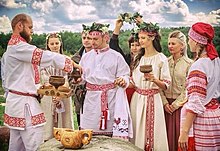Rodism
As Rodismus (rare dt. Rodnowerei from Russ. Родноверие / Rodnoverie and Polish. Rodzima Wiara or Rodzimowierstwo and ukr. Рідянство / Ridjanstvo or Рідновірство / Ridnovirstvo ) or Slavic neo-paganism refers to contemporary efforts to revive the pre-Christian ethnic religion of the Slavs , citing on culture and mythology . It was and is shaped by aspects of pantheism , henotheism and polytheism .
In Poland , where Neo-Pagan movements found their first followers at the end of the 18th century, Rodism has been an officially recognized religious community since 1995. In Russia , however, Ynglism emerged at the end of the 20th century .
See also
literature
- Kaarina Aitamurto: Neoyazychestvo or Rodnoverie? Reflection, Ethics and the Ideal of Religious Tolerance in the Study of Religion , Aleksanteri Institute (Finnish Center for Russian and East European Studies), Omsk 2007, ISBN 978-5-98867-009-4
- Adrian Ivakhiv: In Search of Deeper Identities Neopaganism and "Native Faith" in Contemporary Ukraine , in Nova Religio 8 (3) 2005, pages 7-38
- Victor Shnirelman: "Christians, Go Home!": A Revival of Neo-Paganism Between the Baltic Sea and Transcaucasia , in Journal of Contemporary Religion 17 (2) 2002, pages 197-211
- Scott Simpson: Native Faith: Polish Neo-Paganism At the Brink of the 21st Century , Nomos 2000, ISBN 83-88508-07-5
- Victor Shnirelman: Russian Neo-Pagan Myths and Antisemitism , Vidal Sassoon International Center for the Study of Antisemitism, Jerusalem 1998, without ISBN
- Stanisław Potrzebowski : Zadruga: Eine Völkische Movement in Poland , Institute for Applied Social History, Bonn 1982, ISBN 978-3-92342-800-7
- Piotr Wiench: Neo-Paganism in Central Eastern European Countries , in New Religious Phenomena in Central and Eastern Europe , Nomos 1997, ISBN 83-85527-56-7

